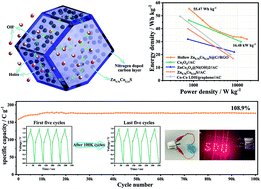Effective synthetic strategy for Zn0.76Co0.24S encapsulated in stabilized N-doped carbon nanoarchitecture towards ultra-long-life hybrid supercapacitors†
Abstract
Hollow Zn0.76Co0.24S@N-doped carbon (HZCS@NC) electrode with hierarchical pores structure synthesized by a continuous ingenious method is presented in response of the demand of high-performance supercapacitors. The formation mechanism of the hollow structure, in which the Zn0.76Co0.24S nanoparticles were embedded in a nitrogen-doped carbon layer, was analyzed in this work. This electrode exhibits an excellent specific capacity of 937 C g−1 at 1 A g−1 and a satisfying capacity retention rate of about 112% after 40 000 cycles at a rate of 5 A g−1. Such preeminent performance is realized via (1) the short electrolyte diffusion length caused by the hollow structure, (2) the high electrochemical activities provide by the bimetallic sulfide and heteroatom doping, (3) the efficient combination of faradaic and electrical double layer materials, and (4) the conductive network with multiple holes. The evaluation of electrochemical performance of the assembled HZCS@NC//RGO hybrid supercapacitor (HSC) was also done. Impressively, the HSC gives a satisfactory energy density of 55.47 W h kg−1, a maximum power density of 16.55 kW kg−1, and an ultra-long (100 000) cycling life (108.9% retention of the initial capacity). This study presents a novel strategy for engineering stable poly-porous multicomponent hollow structures for the fabrication of prospective energy storage devices.



 Please wait while we load your content...
Please wait while we load your content...